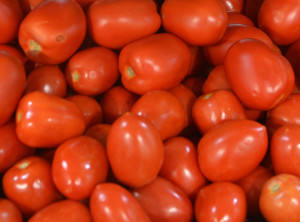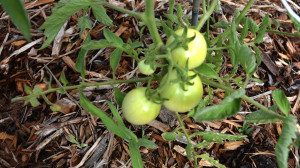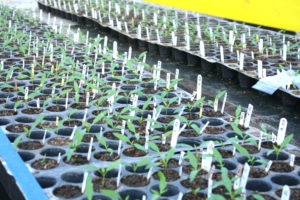Amarillo, Texas, USA
September 18, 2015
High-value vegetable production with a focus on tomatoes in the Texas High Plains will be the target of a new research program by Dr. Charlie Rush, Texas A&M AgriLife Research plant pathologist in Amarillo.



From the greenhouse to the field to the supermarket, Dr. Charlie Rush is beginning a program to look at tomato growth in the High Plains. (Texas A&M AgriLife Communications photos by Kay Ledbetter)
“This will be the first study for the Texas High Plains that will compare production from different tomato cultivars under center pivot irrigation and field and high tunnel drip irrigation in terms of yield and quality, disease and insect pressure, and crop water-use efficiency,” Rush said.
The multidisciplinary, multi-agency project will include AgriLife Research, the Texas A&M AgriLife Extension Service, U.S. Department of Agriculture Agricultural Research Service and West Texas A&M University personnel.
More than 32,000 acres of fresh market tomatoes were planted in Texas in the 1960s, but by 2009 this number was reduced to less than 1,000 acres, Rush said. The majority of this lost acreage went to Mexico and Florida, and at today’s yields and prices it represents approximately $250 million per year in lost revenue.
“There has been a major interest expressed by retailers in the state and other clientele to develop a more stable supply of high quality locally grown vegetables, specifically tomatoes,” Rush said. “Everybody loves fresh tomatoes, but often when you buy them in the supermarket, the taste is not there.”
He said in order for Texas vegetable growers to take advantage of this opportunity and be able to supply the high quality tomatoes that retail marketers and consumers want, they need production information that is regionally adapted.
The team comprised of irrigation and agricultural engineers, plant pathologists, vegetable production specialists, entomologists and an agricultural economist will determine how tomato production competes with row crops in terms of return on investment, especially when water may be a limiting condition, he said.
“We are looking at high-value vegetable crops on a smaller acreage, thus using less overall water for the potential of a huge return,” he said. “Not only are we trying to meet a need of the consumer for locally grown produce, but we are looking to help the producer maintain or increase their income with less water.”
The research will take place on an allotted 2-acre tract of land at the USDA/AgriLife Research Conservation and Production Research Laboratory near Bushland. The study will examine the return for each acre-inch of irrigation water applied in crop production, and thereby the potential to conserve groundwater by reducing irrigation of comparatively lower-value crops.
“Currently, farmers in the High Plains apply from 19 to 25 inches of irrigation water to produce an average of 225 bushels of corn, with expected revenue of $792 per acre,” Rush said. “With the same amount of water, farmers could produce approximately 140 hundredweight of tomatoes, and at prices near $60 per hundredweight, they could dramatically improve their ‘revenue to irrigation ratio.’”
He said the project will start with six-week old tomato plants grown in a greenhouse and then transplanted to field areas where they will be irrigated. Mid- to large-size slicing cultivars, with demonstrated heat tolerance, will be selected for these studies.
The comparison of crop yield and quality, water-use efficiency, pest pressure and economic viability will be conducted in field trials under center pivots, drip irrigation and a new form of irrigation – root demand irrigation or RDI – similar to a soaker hose.
Additionally, four high tunnels will be built, beginning this fall, for a more protected environment, Rush said.
High tunnels are similar to greenhouses, although they do not have electricity. The plastic covering provides protection from the elements often experienced in the High Plains during the growing season, including high winds, hail and sun scald, he said.
“The plastic cover also allows earlier planting and a prolonged growing season, which will allow producers to meet different market windows,” Rush said.
The long-term goal of this project is to determine the feasibility of commercial tomato production in the Texas Panhandle and provide current and potential vegetable growers with the information needed to produce a high yielding, high quality crop, he said.
Rush said although tomatoes will be the focus of the initial study, the high tunnels can and will be used for growing winter vegetables and determining if double cropping is an alternative.
“We need to adapt this proven technology to the realities of production in the High Plains and see what opportunities it can provide for producers,” he said.
The two-year initial project could be expanded to include multiple crops over the next five years, Rush said.